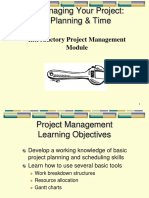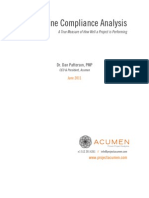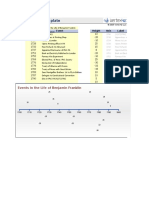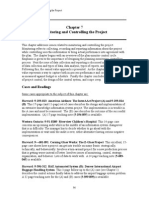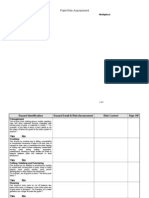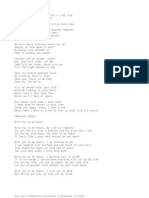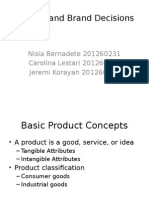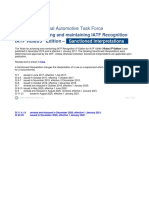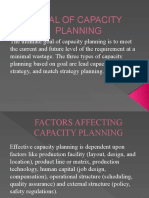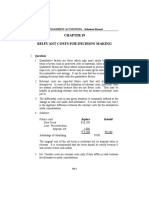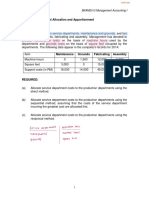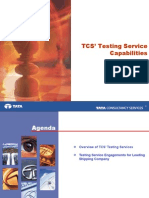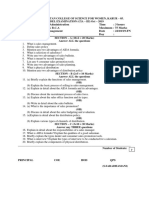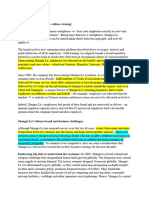Project Monitoring & Control
Monitoring and Information
Systems
Evaluation and control of projects are the opposite
sides of project selection and planning
Logic of selection dictates the components to be
evaluated
The details of the planning expose the elements to be
controlled
Monitoring is the collecting, recording, and reporting
information concerning any and all aspects of project
performance
The Planning - Monitoring Controlling Cycle
The key things to be planned, monitored, and
controlled are time (schedule), cost (budget), and
specifications
The planning methods require a significantly
greater investment of time and energy early in the
life cycle of the project
These methods significantly reduce the extent and
cost of poor performance and time/cost overruns
The Planning - Monitoring Controlling Cycle
The control process should be perceived as a
closed loop system
In a closed loop system, revised plans and
schedules should follow corrective actions
The planning-monitoring-controlling cycle is
continuously in process until the project is
complete
�Designing the Monitoring
System
Information Flow for the Planning Monitoring - Controlling Cycle
The first step in setting up any monitoring system is
to identify the key factors to be controlled
The project manager must define precisely which
Designing the Monitoring
System
The best source of items to be monitored is
the project action plan
The monitoring system is a direct connection
between planning and control
It is common to focus monitoring activities on
data that are easily gathered - rather than
important
Monitoring should concentrate primarily on
measuring various facets of output rather
than intensity of activity
specific characteristics of performance, cost, and
time should be controlled
Exact boundaries must then be established, within
which control should be maintained
Designing the Monitoring
System
The measurement of project performance usually
poses the most difficult data gathering problem
Performance criteria, standards, and data collection
procedures must be established for each of the
factors to be measured
Information to be collected may consist of
accounting data, operating data, engineering test
data, customer reactions, specification changes and
the like
�How to Collect Data
It is necessary to define precisely what pieces
of information should be gathered and when
A large proportion of all data collected take
one of the following forms:
Frequency counts
Raw numbers
Subjective numeric ratings
Indicators
Verbal measures
How to Collect Data
A count of bugs found during a series of
tests run on a new piece of software:
How to Collect Data
After data collection has been completed,
reports on progress should be generated
These reports include project status reports,
time/cost reports, and variance reports
Causes and effects should be identified and
trends noted
Plans, charts and tables should be updated on
a timely basis
How to Collect Data
Percent of specified performance met during
repeated trials
�How to Collect Data
Monitoring can serve to maintain high morale
on the project team
Monitoring can also alert team members to
problems that will have to be solved
The purpose of the monitoring system is to
gather and report data
The purpose of the control system is to act on
the data
How to Collect Data
The project manager is often dependent on team
members to call attention to problems
The project manager must make sure that the
bearer of bad news is not punished; nor the
admitter-to-error executed
The hider-of-mistakes may be shot with impunity and then sent to corporate Siberia
How to Collect Data
Significant differences from plan should be
highlighted or flagged so that they cannot be
overlooked by the controller
Some care should be given to the issues of honesty
and bias
An internal audit serves the purpose of ensuring all
information gathered is honest
No audit can prevent bias - all data are biased by
those who report them
Information Needs and the
Reporting Process
The monitoring system ought to be constructed so
that it addresses every level of management
Reports do not need to be of the same depth or at the
same frequency for each level
The relationship of project reports to the project
action plan or WBS is the key to the determination of
both report content and frequency
�Information Needs and the
Reporting Process
Reports must contain data relevant to the control of
specific tasks that are being carried out according to
a specific schedule
The frequency of reporting should be great enough to
allow control to be exerted during or before the
period in which the task is scheduled for completion
The timing of reports should generally correspond to
the timing of project milestones
Information Needs and the
Reporting Process
The nature of the monitoring system should be
consistent with the logic of the planning, budgeting,
and scheduling systems
The primary objective is to ensure achievement of the
project plan through control
The scheduling and resource usage columns of the
project action plan will serve as the key to the design
of project reports
Information Needs and the
Reporting Process
Benefits of detailed, timely reports delivered to the proper
people:
Mutual understanding of the goals of the project
Awareness of the progress of parallel activities
More realistic planning for the needs of all groups
Understanding the relationships of individual tasks to one
another and the overall project
Early warning signals of potential problems and delays
Faster management action in response to unacceptable or
inappropriate work
Higher visibility to top management
Report Types
For the purposes of project management, we
can consider three distinct types of reports:
Routine
Exception
Special analysis
Routine reports are those issued on a regular
basis
�Report Types
Exception reports are useful in two cases:
First, they are directly oriented to project
management decision making and should be
distributed to the team members who will have a
prime responsibility for decisions
Second, they may be used when a decision is
made on an exception basis and it is desirable
to inform other managers as well as to
document the decision
Report Types
Special analysis reports are used to
disseminate the results of special studies
conducted as a part of the project
These reports may also be used in response to
special problems that arise during the project
Usually they cover matters that may be of interest
to other project managers, or make use of analytic
methods that might be helpful on other projects
Meetings
Most often, reports are delivered in face-to-face
meetings, and in telephone conference calls
Some simple rules can lead to more productive
meetings:
Use meetings for making group decisions
Have preset starting and stopping times
Make sure that homework is done prior to the
meeting
Meetings
Some simple rules for more productive meetings
(cont.):
Avoid attributing remarks or viewpoints to
individuals in the meeting minutes
Avoid overly formal rules of procedure
If a serious problem or crisis arises, call a meeting
for the purpose of dealing with that issue only
�The Earned Value Chart
Common Reporting Problems
There are three common difficulties in the
design of project reports:
There is usually too much detail, both in the
reports themselves and the input being solicited
from workers
Poor interface between the project information
system and the parent firms information system
Poor correspondence between the planning and
the monitoring systems
The Earned Value Chart
The earned value of work performed (value
completed) for those tasks in progress is found by
multiplying the estimated percent completion for each
task by the planned cost for that task
The result is the amount that should have been spent
on the task so far
The concept of earned value combines cost reporting
and aggregate performance reporting into one
comprehensive chart
One way of measuring overall performance
is by using an aggregate performance
measure called earned value
A serious difficulty with comparing actual
expenditures against budgeted or baseline is
that the comparison fails to take into account
the amount of work accomplished relative to
the cost incurred
The Earned Value Chart
Graph to evaluate cost and performance to
date:
�The Earned Value Chart
Variances on the earned value chart follow two primary
guidelines:
1. A negative is bad
2. The cost variances are calculated as the
earned value minus some other measure
BCWP - budgeted cost of work performed
ACWP - actual cost of work performed
BCWS - budgeted cost of work scheduled
STWP - scheduled time for work performed
ATWP - actual time of work performed
The Earned Value Chart
BCWP - ACWP = cost variance (CV, overrun is negative)
BCWP - BCWS = schedule variance (SV, late is negative)
STWP - ATWP = time variance (TV, delay is negative)
If the earned value chart shows a cost overrun or performance
underrun, the project manager must figure out what to do to get the
system back on target
Options may include borrowing resources, or holding a meeting of
project team members to suggest solutions, or notifying the client that
the project may be late or over budget
Cost/Schedule Control System
Criteria (C/SCSC)
The Earned Value Chart
Variances are also formulated as ratios
rather than differences
C/SCSC was developed by the U.S. Department of
Cost Performance Index (CPI) = BCWP/ACWP
Schedule Performance Index (SPI) =
Time Performance Index (TPI) = STWP/ATWP
BCWP/BCWS
Use of ratios is particularly helpful when
comparing the performance of several
projects
One note, Microsoft Project 98 does not calculate cost variance as
defined by the PMI. They do it in reverse.
Defense in the late 1960s and was required for defense
projects
It was an extension of the earned value analysis
It spelled out a number of standards of organization,
accounting, budgeting, etc. that firms must meet if they
are to be considered acceptable for government contracts
It is usually not required on government projects, but still
is required by some businesses
�Cost/Schedule Control System
Criteria (C/SCSC)
For purposes of control, it is just as
important to emphasize the need to relate the
realities of time, cost, and performance with
the projects master plan
To do this, the set of action plans (the project
master plan) must be kept up to date
Cost/Schedule Control System
Criteria (C/SCSC)
Differences between work scheduled and work
planned can develop from several different causes:
Official change orders in the work elements
Informal alterations in the methods used
Official or unofficial changes in the tasks to be
accomplished
If the plan is not altered to reflect such changes,
comparisons between plan and actual are not
meaningful
Milestone Reporting
Milestone reports serve to keep all parties
up to date on what has been accomplished
If accomplishments are inadequate or late,
these reports serve as starting points for
remedial planning
Project Baseline
Baseline duration
Baseline Start
Baseline Finish
Baseline duration
Baseline Cost
�Actuals
Actual duration
Actual Start
Actual Finish
Actual duration
Actual Cost
In-progress
Percent Completion
Weighted % completion
Remaining duration
Monitoring
Tracking Table
Entering Progress data
An Example
5 day job
Review after 3 days
40 % complete (remaining duration = ?)
Suppose remaining duration is 4 days
(duration value increases)
10
�Variance Analysis
Plan vs. Actual
Limitations
Earned Value Analysis
Budgeted Cost of Work Scheduled
Budgeted Cost of Work Performed
Actual Cost of Work Performed
Cost Overrun = ACWP - BCWP
S-Curve
Earned Value graph
For total project
For every department
Milestones
Achieving milestones
Project successful completion
11
�Project Control
Control is the last element in the
Project Control
implementation cycle of planning-monitoringcontrolling
Control is focused on three elements of a
project
Performance
Cost
Time
Controlling Performance
There are several things that can cause a projects
performance to require control:
Unexpected technical problems arise
Insufficient resources are available when needed
Insurmountable technical difficulties are present
Quality or reliability problems occur
Client requires changes in specifications
Interfunctional complications arise
Technological breakthroughs affect the project
Controlling Cost
There are several things that can cause a projects
cost to require control:
Technical difficulties require more resources
The scope of the work increase
Initial bids were too low
Reporting was poor or untimely
Budgeting was inadequate
Corrective control was not exercised in time
Input price changes occurred
12
�Controlling Time
There are several things that can cause a projects
schedule to require control:
Technical difficulties took longer than planned to resolve
Initial time estimates were optimistic
Task sequencing was incorrect
Required inputs of material, personnel, or equipment were
unavailable when needed
Necessary preceding tasks were incomplete
Customer generated change orders required rework
Governmental regulations were altered
Purposes of Control
There are two fundamental objectives of control:
1. The regulation of results through the alteration of
activities
2. The stewardship of organizational assets
The project manager needs to be equally attentive to
both regulation and conservation
The project manager must guard the physical assets of
the organization, its human resources, and its financial
resources
Physical Asset Control
Requires control of the use of physical assets
Concerned with asset maintenance, whether preventive or
corrective
Also the timing of maintenance or replacement as well as the
quality of maintenance
Setting up maintenance schedules in such a way as to keep the
equipment in operating condition while minimizing interference
to ongoing work
Physical inventory whether equipment or material must also be
controlled
Human Resource Control
Stewardship of human resources requires
controlling and maintaining the growth
and development of people
Projects provide fertile ground for
cultivating people
Because projects are unique, it is possible
for people working on projects to gain a
wide range of experience in a reasonably
short period of time
13
�Financial Resource Control
The techniques of financial control, both
conservation and regulation, are well known:
Current asset controls
Project budgets
Capital investment controls
These controls are exercised through a series of
analyses and audits conducted by the
accounting/controller function
Financial Resource Control
Representation of the accounting/controlling
function on the project team is mandatory
The parent organization is responsible for the
conservation and proper use of resources owned
by the client or charged to the client
Due diligence requires that the organization
proposing a project conduct a reasonable
investigation, verification, and disclosure of all
material facts relevant to the firms ability to
conduct the project
Control of Change and Scope
Creep
The project managers best hope is to control the
process by which change is introduced and
accomplished
This can be done with a formal change control
system that is able to:
Review all requested changes and identify all task impacts
Translate those impacts into project performance, cost,
and schedule
Evaluate the benefits and costs of the requested changes
Accept or reject the changes and communicate to all
concerned parties
Ensure that changes are implemented properly
Effective Change Control
Procedure
The following guidelines, applied with reasonable
rigor, can be used to effectively control changes:
1. All project contracts or agreements must include a
description of how requests for a change in the
projects plan, budget, schedule, and/or
deliverables, will be introduced and processed
2. Any change in a project will be in the form of a
change order that will include a description of the
agreed-upon change together with any changes in
the plan, budget, schedule, and/or deliverables that result
from the change
14
�Effective Change Control
Procedure
3. Changes must be approved, in writing, by the
clients agent as well as by an appropriate
representative of senior management of the firm
responsible for carrying out the project
4. The project manager must be consulted on all
desired changes prior to the preparation and
approval of the change order. The project
managers approval, however, is not required
5. Once the change order has been completed and
approved, the project master plan should be
amended to reflect the change, and the change
order becomes part of the master plan
Thank You
15



































